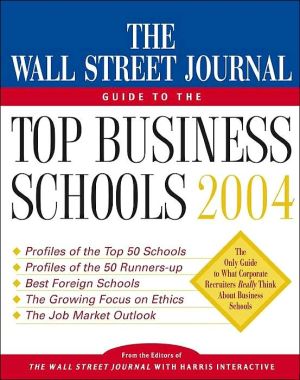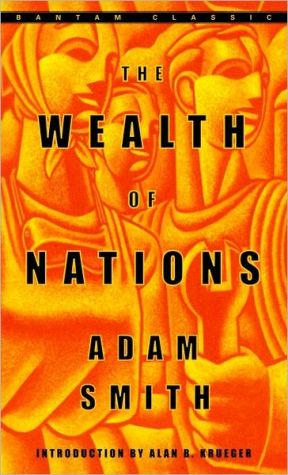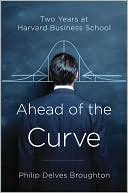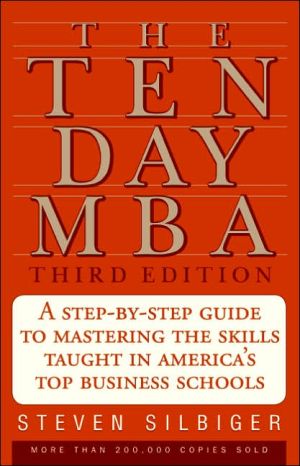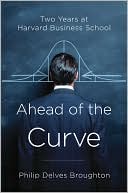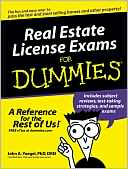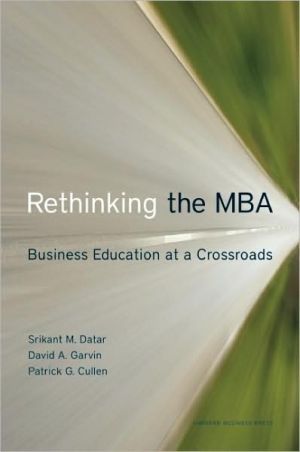The Wall Street Journal Guide to the Top Business Schools 2004
THE MOST UP-TO-DATE EDITION OF THE GROUNDBREAKING BUSINESS-SCHOOL GUIDE FROM THE WORLD'S MOST RESPECTED BUSINESS PUBLICATION\ For years, prospective M.B.A. students seeking guidance on which business schools to consider have had to rely on rankings compiled with vague methodologies, subject to the biased opinions of students and school administrators. Now come The Wall Street Journal and Harris Interactive, the worldwide market-research firm, with their third annual survey that has become the...
Search in google:
THE MOST UP-TO-DATE EDITION OF THE GROUNDBREAKINGBUSINESS-SCHOOL GUIDE FROM THE WORLD'S MOST RESPECTED BUSINESS PUBLICATIONFor years, prospective M.B.A. students seeking guidance on which business schools to consider have had to rely on rankings compiled with vague methodologies, subject to the biased opinions of students and school administrators. Now come The Wall Street Journal and Harris Interactive, the worldwide market-research firm, with their third annual survey that has become the single most important reference tool for students, school administrators, and corporate recruiters. Using a carefully constructed methodology and Harris Interactive's online polling expertise, The Wall Street Journal Guide to the Top Business Schools 2004 shows students what corporate recruiters — the "buyers" of budding management talent — really think of the schools and their students.Each profile of the 50 top M.B.A. programs, as well as of the 50 runners-up, includes information on admissions, enrollment, test scores, the industries and companies most likely to hire the school's graduates, and graduates' expected first-year salaries. The Wall Street Journal Guide to the Top Business Schools 2004 also covers:THE DEBATE OVER THE VALUE OF AN M.B.A. DEGREE • THE SMARTESTAPPLICATION STRATEGIES • SURVIVAL TACTICS FOR A BLEAK JOB MARKETTHE SALARY AND BONUS OUTLOOK • TOP SCHOOLS FOR MINORITIES TOP SCHOOLS FOR WOMEN • ETHICS EDUCATION IN A POST-ENRON WORLDand includes lists of: TOP PUBLIC AND PRIVATE SCHOOLS • TOP LARGE AND SMALL SCHOOLS • TOP SCHOOLS BY REGION • TOP SCHOOLS BY INDUSTRY• TOP SCHOOLS BY ACADEMIC DISCIPLINE • "HIDDEN GEMS"
Introduction\ Who wants an M.B.A. degree in this wretched job market?\ Quite a few folks, actually. About 100,000 newly minted M.B.A.s are still flooding the workplace every year. Granted, many of them are struggling to find jobs, but most still see long-term value in the traditional passport to the executive suite. They still value the skills they mastered and the high-powered network of alumni they plugged in to.\ Questioning the degree's value is certainly understandable, though. After reaching record levels in 2002, the number of people taking the Graduate Management Admission Test (GMAT) has started trailing off. Even some business school academics have raised doubts about the degree's worth.\ During the go-go economy of the 1990s, applying to business school wasn't such a risky decision. Many M.B.A.s were netting multiple job offers, six-figure salaries, and an embarrassment of riches in their packages of bonuses and perks. The days of such instant gratification are long gone. Deciding whether to invest $100,000 or more to earn the degree today requires much more careful thought and planning.\ That's where the new edition of The Wall Street Journal Guide to the Top Business Schools comes in. It will help prospective students decide whether it's the right time to head back to campus. And if so, it will be an invaluable guide in picking the program that's the best fit, with its detailed profiles of the 100 business schools that received the most ratings in the third annual Wall Street Journal/Harris Interactive survey of corporate recruiters. We cut through the hype by providing only the most important facts about the M.B.A. programs and by telling you what corporate recruiters — the buyers of M.B.A. talent — think of the schools and their students.\ This year's ranking is sure to attract plenty of attention because there's a new No. 1 school. After two years in the top spot, the Tuck School of Business at Dartmouth College is no longer the favorite of recruiters. They have warmed instead to the Wharton School, the finance powerhouse at the University of Pennsylvania.\ While rankings are but one criterion in the selection of an M.B.A. program, they are a very useful way to distinguish one business school from another. The book includes extensive data about the 50 top-ranked business schools in The Wall Street Journal/Harris Interactive survey, plus information about the 50 runner-up schools. It is a global mix of schools, with six international M.B.A. programs among the top 50 and 20 more in the runner-up list. What's more, we tell you which schools are best in which academic disciplines.\ The essays in the book provide up-to-the-minute insights about the M.B.A. world from the application process on the front end to the job market at graduation. We also cover the hot-button issues on campus: the M.B.A. value question, curriculum changes, job-hunting tactics, and diversity.\ Rather than dwell on the dismal nature of the M.B.A. job market, we focus on how some students not only survived it, but succeeded in reaching what they thought would be an impossible dream — changing careers. You'll learn how they did it through a combination of pluck and plain old hard work.\ To gain an edge in the application process, read the advice of admissions directors at some of the top business schools. We asked them for tips on how prospective students can stand out. Among their suggestions: write knockout essays that tell what makes you so special (creativity is a plus, but please don't bring pizza to the interview), don't play back information from the school catalog in your admissions interview (your interviewer probably wrote it), and don't make silly excuses for your mediocre GMAT score (instead, give the test another try).\ Once admitted, students almost certainly will find themselves studying ethics and working on leadership training. Many schools are revamping their curricula, and ethics and leadership are the two buzzwords right now. After receiving some of the blame for the rash of corporate accounting scandals, business schools are trying to make amends by peppering their courses with ethics lessons. They don't expect to turn out choirboys and girls, but they do hope to spark some serious discussion about morality in the workplace.\ The book also devotes considerable attention to diversity in M.B.A. programs. We consider the plight of international students, the lack of progress in attracting more women and racial and ethnic minorities to business schools, and the status of a more invisible minority — gay and lesbian students. Diversity in business schools seems more relevant than ever after the Supreme Court's recent rulings in favor of gay rights and affirmative action. As in most of society, the business schools and the corporations that hire their graduates have far to go to achieve full equality.\ The heart of the book is The Wall Street Journal/Harris Interactive business school survey. It's the only one that focuses exclusively on what recruiters think of M.B.A. programs — and the results are consequently quite different from other rankings. But it is the recruiter's opinion that really matters most to prospective students, who are returning to business school for one reason: to increase their marketability in a highly competitive job market. How well they achieve their goal depends on how companies view the schools they attend. And such information is more valuable than ever now that recruiters are hiring far fewer M.B.A. graduates.\ Business school deans and career-services directors are keen to learn about their weak spots and to listen to recruiters' advice for improving the school's reputation. And recruiters themselves, facing constant competition for the cream of the M.B.A. class, also find the ranking useful in identifying schools to add to their list of "talent suppliers." They are likely to find surprises in the list of "hidden gems" — schools that aren't typically ranked in the top tier but sparkle for some recruiters.\ Because of the survey's recruiter focus, we included only full-time programs. Part-time M.B.A. programs attract few recruiters because most of their students are already employed. And most executive M.B.A. students are sponsored by their employers and aren't in the job market at all.\ Only people making hiring decisions rated specific schools — and only schools they knew from firsthand experience. We didn't want the evaluations to be based purely on the past reputations of the schools. We interviewed the people out in the field now doing the actual recruiting — the heads of business units, line managers and others — not just the human-resources executives at corporate headquarters. And we made sure we contacted a broad range of recruiters, from large companies like Citigroup and Dell to small consulting and high-tech firms.\ Our survey is also distinctive because it is the only one conducted by a major research firm. Harris Interactive, which produces the well-known Harris public-opinion poll, brought its expertise to the project, from the development of the survey instrument to the analysis of the results. The talented Harris team includes its leader, Joy Sever; David Bakken; Deirdre Wanat; Oliver Freedman; and Nina Doyle.\ Daniel Nasaw at The Wall Street Journal did a superb job helping assemble and fine-tune the vast amount of data in this book. Steve Adler and Roe D'Angelo from The Wall Street Journal provided terrific support. At Simon & Schuster, Elizabeth Stein and Stephanie Fairyington contributed their valuable insights and editing skills to the guidebook. But above all, we want to express our gratitude to the many business school officials and corporate recruiters who once again helped make the survey such a success.\ Copyright © 2002, 2003 by Dow Jones & Company, Inc.
ContentsIntroduction Part One The M.B.A. OutlookThe Survey ResultsThe Top 50 Business Schools The 50 Runner-up Schools The Top 10 International Schools The Top U.S. Schools by Region The Top Public and Private Schools The Top Large and Small Schools Industry Rankings of Top Schools Hidden Gems Honor Roll of Schools by Academic Discipline Top Student and School Attributes Leadership Lessons Ethics in the Classroom Ethics in the Job InterviewWinning Job Search Strategies M.B.A. Salaries Debate over the M.B.A.'s Value Admission Tips Challenges for International Students M.B.A. Issues for Women The Minority Student Shortage Out of the Closet in Business School Part Two: The Top 50 Business Schools 1. University of Pennsylvania (Wharton School) 2. Dartmouth College (Tuck School of Business) 3. University of Michigan 4. Northwestern University (Kellogg Graduate School of Management)5. University of Chicago 6. Carnegie Mellon University 7. Columbia University 8. Harvard University 9. Yale University 10. University of North Carolina at Chapel Hill (Kenan-Flagler Business School) 11. Purdue University (Krannert School of Management)12. Indiana University (Kelley School of Business) 13. University of Texas at Austin (McCombs School of Business)14. University of California at Berkeley (Haas School of Business) 15. Vanderbilt University (Owen Graduate School of Management)16. Instituto Tecnológico y de Estudios Superiores de Monterrey (ITESM)17. Duke University (Fuqua School of Business) 18. University ofRochester (William E. Simon Graduate School of Business Administration)19. University of Maryland (Robert H. Smith School of Business)20. Cornell University (Johnson Graduate School of Management)21. Michigan State University (Eli Broad Graduate School of Management)22. Massachusetts Institute of Technology (Sloan School of Management)23. Emory University (Goizueta Business School) 24. Instituto Panamericano de Alta Dirección de Empresa — IPADE25. Ohio State University (Fisher College of Business)26. Brigham Young University (Marriott School of Management)27. Wake Forest University (Babcock Graduate School of Management)28. Washington University (John M. Olin School of Business)29. University of Virginia (Darden Graduate School of Business Administration)30. Stanford University 31. University of Notre Dame (Mendoza College of Business)32. Southern Methodist University (Edwin L. Cox School of Business)33. University of Pittsburgh (Katz Graduate School of Business)34. Thunderbird, the American Graduate School of International Management35. University of Florida (Warrington College of Business)36. Instituto de Empresa (IE) 37. New York University (Leonard N. Stern School of Business)38. University of California at Los Angeles (Anderson School)39. University of London (London Business School) 40. University of Southern California (Marshall School of Business)41. College of William and Mary 42. American University (Kogod School of Business) 43. University at Buffalo, State University of New York44. University of Denver (Daniels College of Business)45. Boston University 46. Escuela Superior de Administracion y Dirección de Empresas (ESADE)47. Texas A&M University (Lowry Mays Graduate School of Business)48. HEC School of Management, Paris 49. University of Minnesota (Carlson School of Management)50. University of Illinois at Urbana-Champaign Part Three: The Runners-up Arizona State University (W. P. Carey School of Business)Australian Graduate School of Management Babson College (F. W. Olin Graduate School of Business)Boston College (Carroll School of Management) Case Western Reserve University (Weatherhead School of Management)Concordia University (John Molson School of Business)Cranfield University E. M. Lyon Erasmus University (Rotterdam School of Management)ESSEC Business School Fordham University George Washington University Georgetown University (McDonough School of Business)Georgia Institute of Technology (DuPree College of Management)Georgia State University (Robinson College of Business)HEC Montréal Helsinki School of Economics IESE, the International Graduate School of Management of the University of NavarraIMD International INSEAD International University of Japan McGill University Oklahoma State University Pennsylvania State University (Smeal College of Business Administration)Pepperdine University (Graziadio School of Business and Management)Queen's University Rice University (Jesse H. Jones Graduate School of Management)Rollins College (Crummer Graduate School of Business)Rutgers, the State University of New Jersey Texas Christian University (Neeley School of Business)Tulane University (A. B. Freeman School of Business)University of Arizona (Eller Graduate School of Management)University of British Columbia University of California at Davis University of California at Irvine University of Colorado at Boulder (Leeds School of Business)University of Connecticut University College Dublin (Michael Smurfit Graduate School of Business)University of Georgia (Terry College of Business) University of Iowa (Henry B. Tippie School of Management)University of Miami University of Oxford (Said Business School) University of San Francisco University of South Carolina (Moore School of Business)University of Toronto (Joseph L. Rotman School of Management)University of Utah (David Eccles School of Business) University of Washington University of Western Ontario (Richard Ivey School of Business)University of Wisconsin-Madison York University (Schulich School of Business) Appendix: Methodology Index
